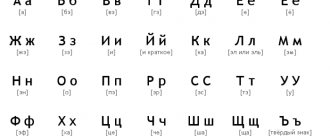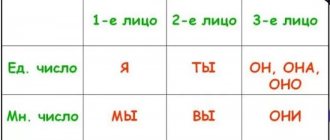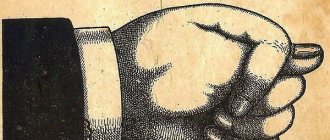There are two amazing letters in the Russian alphabet - b and b - they do not represent sounds! Why are they needed then? Let's talk about the importance of the soft sign in the Russian language, its function in speech and the rules of use.
The soft sign b, b is one of two letters of the Russian alphabet, the 30th in a row, which does not convey any sound. It serves to indicate the softness of consonants in writing. It just so happens in the Russian language system that all consonants can be divided into soft and hard.
The role of one letter
The soft sign is one of the letters whose function has changed during the development of language. Once upon a time this letter was called “er” and denoted a very short vowel sound (reduced) - something between E and I.
As a result of the development of language, the sound denoted by the letter er disappeared. If this letter was stressed, it became E; if there is no stress in the middle of the word, it simply disappears (this is what explains the alternation with zero sound: stump - stump, for example); at the end of a word it began to denote the softness of a consonant.
The spelling of the soft sign b consists of observing 4 groups of rules:
1) soft separator: spelling;
2) the use of a soft sign to indicate the softness of consonants;
3) soft sign after hissing ones;
4) a soft sign in some case and verbal forms.
So, a soft sign can be an indicator of the softness of a consonant (day). May indicate a grammatical feature (for example, the 3rd declension of a noun: help, but cloak). Or it can be divisive.
Test on the topic
- /10
Question 1 of 10The soft sign in Russian can
Start test
Hall of Fame
To get here, take the test.
- Natalia Barsukova
8/10
- Tatyana Kutukova
7/10
- Nadezhda Zaitseva
9/10
- Sergey Efremov
9/10
- Elena Skopina
8/10
Dividing soft sign
The soft dividing sign is so called because it seems to divide the word into parts: the part after the sign is pronounced as if a new word begins from this place. If, for example, the letter I appears after the soft separating sign, it is read in the same way as at the beginning of the word: [ya].
Let's look at examples:
- Article – [stat'y'a´]
- Drinks – [p'yo´t]
- Blizzard [vyu´ga]
The vowels E, E, Yu, I after the soft separating sign each denote two sounds: e - [y'e], e - ]y'o], yu - [y'u], I - [y'a].
In what cases is a soft separator used? After any consonant, except Y, before E, Yo, Yu, Ya, I. In this case, the consonant sound will not necessarily sound soft, since in this case the soft sign performs a different task.
However, it is important to remember that this rule does not apply after prefixes. After consonant prefixes, before E, Yo, Yu, Ya, a hard separator is placed, not a soft one!
The separating soft sign is written:
- before e, e, i, yu, I am inside the word, not after prefixes , for example: career, curious, passerine, blizzard, monkey ;
- in compound words , if the soft sign was in the first word, for example: flour mill, Svyazinvest;
- before O in the following borrowed (foreign language) words , an almost complete list: battalion, broth, guillotine, canyon, companion, cotillion, Cro-Magnon, lotion, medallion, minion, monsignor, pavilion, papillotte, postman, senor, fjord, champignon, chignon, goatee .
So, in accordance with the rule, the separating soft sign is written after the consonant before E, Yo, Yu, Ya, I anywhere in the sentence, except for the position after the prefix.
How to correctly separate words with a soft sign for hyphenation: rules, examples
Rules for spelling a soft sign
Words with a soft sign are separated for hyphenation in the same way as other words without “b”.
The main rule: The soft sign before the hyphen remains on the previous line, along with the previous syllable.
Here are some examples for correct hyphenation of words with a soft sign:
Soft sign spelling rules
Designation of softness of consonants
- At the end of a word, the sign b is written after any soft consonant, for example: horse (cf. windows), coal (cf. corner), lantern, blow (cf. blow).
- In the middle of the word a soft sign is written:
- after a soft L , standing before any consonant (hard or soft), for example: sick, herring, boy, sawyer ;
- after a soft consonant standing before a hard consonant , for example: Kuzma, less, struggle ;
- between two soft consonants only if, when the word changes, the second consonant becomes hard, and the first remains soft, for example: in a request (request), Kuzmich (Kuzma), about struggle (struggle).
- The letter b is not written inside the combinations chk, chn, nch, nshch, rshch, rch : river, river, nurse, mason, lamplighter, casket.
- A soft sign not written between two soft Ls : illusion .
Algorithm for self-test
In order to learn to correctly distinguish words with dividing marks (hard and soft), as well as softening letters, you should analyze several examples in practice, using a certain algorithm of actions. Here is a short guide that will be especially useful for beginning writers and middle school students:
- Write the word down on your notebook and pick up a pencil.
- Take a look at the characteristics of the word and its role in the sentence.
- Determine the part of speech using a question and the meaning of the construction.
- Carry out morphemic analysis, trying to modify some or other parts (root, suffix, prefix).
- Be aware of possible exceptions.
- Draw conclusions and write the correct letter.
As practice shows, students remember the rules much faster if they have completed some tasks designed to reinforce the material. So it’s worth examining one or two interesting examples in practice using the described algorithm of actions. You can even do the exercise with two words at once to make it more interesting: “exhausted” and “hookah”:
- Having written out the examples in a notebook, you must first determine the part of speech. The first is a participle, the second is a noun.
- Next, you need to analyze the composition to determine where the words end and the prefixes begin. In the case of “hookah”, everything is more or less simple - the root is the entire word. But the first example can cause difficulties. Although it is enough to remember what participles are formed from - “to ride” - that is, the root is “ezh” (alternation occurs, then comes the standard suffix “enn”, and the prefix “iz” comes in front).
- According to the rules, it is necessary to write a hard separator in the first example, and a soft one in the second.
- Words are also no exception.
Finding the separating “b” is not as difficult as it might seem at first glance. The most important thing is to remember what the rules say and also practice as much as possible with different examples. In this case, even the most cunning designs will not be able to confuse the writer.
Soft sign after sizzling
After the hissing ones the soft sign is written:
- in nouns of the feminine singular (noun and noun case), for example: speech, silence, rye, mouse, daughter, night;
- in the imperative mood of verbs : appoint, cut, eat, appoint, cut, eat ;
- in the indefinite form of verbs : take care - take care, cut - get a haircut ;
- in the 2nd person singular of verbs of the present and future tense, for example: you carry, you carry, you throw, you rush, you rush, you fiddle;
- in adverbs , for example: unbearable, completely (exceptions: already, married, unbearable );
- in particles you see, that is, only, you see (exceptions: already, already ).
Other cases
The soft sign is used:
- in the instrumental case of the plural of some nouns (for example: children, people, four )
- the numeral eight in all cases (for example: eight, eight, eight );
- in the indefinite form of the verb : to carry - to tinker, to shave - to shave ;
- in the imperative mood of verbs (see Note 1): prepare, prepare, get ready .
- at the end of the following numerals (nominal and vin. case) five, six. seven, eight, nine, ten, eleven, twelve, thirteen, fourteen, fifteen, sixteen, seventeen, eighteen, nineteen, twenty, thirty ;
- before the letter O in some numerals : sextillion, quadrillion, quintillion, septillion, etc.
Notes:
(1) Pay attention to the use in the imperative mood of forms of a verb that has only two forms: the form of the 1st person singular. numbers - lie down and the form of the 2nd person, h. - lie down .
(2) There is a variant spelling of the following numerals: sextillion, quadrillion, quintillion, septillion , etc.
(3) Note: the nouns daughter, bone and whip are in the plural instrumental case. hours have the ending -yami ( daughters, bones, lashes ), and obsolete forms ( daughters, bones, lashes ) in modern language can only be found in phraseological units ( lie with bones, beat with lashes ).
(4) Remember: if the ending -nya is preceded by the letter l , then write a soft sign after it: bathhouse, bell tower, ironing room, smokehouse , etc.
(5) Remember the spelling of adverbs: exactly and colloquially before .
(6) Distinguish the spelling of suffixes -t-(sya ) and others, the infinitive from the suffix -t-(sya) of the form of the 3rd person of the present tense. Compare: She wants to study at the conservatory. studying there ?
(7) Pay attention to the spelling of the following words: that is (that is, namely), tush (musical greeting) and mascara (paint), thinner and thinnest , nanny and nurse .
(8) Pay attention to the peculiarity of the spelling of the word love . The common noun love in indirect cases loses the vowel o: there is no love, to love, about love. The proper name Lyubov retains this vowel in all forms: Young Blok spent a lot of time with Lyubov Dmitrievna Mendeleeva.
Possessive adjectives
Among the examples of “ь” there are often words that are formed by declension and placing possessive adjectives in indirect cases. However, it is worth remembering that this part of speech may not be inclined in all cases. Although in the Russian language you can still find several interesting words that will lend themselves to this rule, for example, “Cossack”. If you try to inflect a possessive adjective, you will see the following picture:
- nominative - Cossack;
- genitive - Cossack;
- dative - Cossack;
- accusative - Cossack;
- instrumental - Cossack;
- prepositional - about Cossack;
Particular attention should be paid to the dative, instrumental and prepositional cases, because it is in them that, in most cases, novice writers make common mistakes, simply forgetting that it is necessary to put “b”. However, it is worth understanding that not all possessive adjectives can decline, and even more so, the root will not always include the letter that must be preceded by “b”.
In words of foreign origin
Let's look at the words used in the sentence: “The postman ate broth with champignons.”
The words “postman”, “broth”, “champignon” are borrowed from the French language. Russian orthography tried to follow the pronunciation of these and other similar words, which explains the atypical for our language spelling of the soft sign before O.
Here are examples of such words:
- Bouillon.
- Medallion.
- Champignon.
- Postman.
- Canyon.
- Cotillion.
- Battalion.
- Pavilion.
Thus, the soft sign is also written in some borrowed words before O (medallion, postman, etc.).
Peculiarities of use in foreign words
The soft dividing sign (the rules of use are given in the next section) will not give two sounds to the letter in all cases. After all, if we take the word “battalion” as an example, we can see that the letter “o” has one sound of the same name, and the sign only gives the “n” softness. However, “ь” is still a separator, since it is in the middle of the word. However, this feature is observed only in those words that were originally borrowed from another language. Here are some interesting examples:
- pavilion;
- cotillion;
- canyon;
- postman;
- champignon;
- medallion;
- bouillon.
For the Russian language, the use of “ь” before the vowel letter “o” is atypical, therefore, in almost all cases, in this way one can almost accurately determine where in the text a word borrowed from a foreign language is located. This can be called the unspoken fourth role of this interesting letter.
However, we should not forget that Russian spelling can change over time, so the list of borrowed words becomes more extensive every year.











